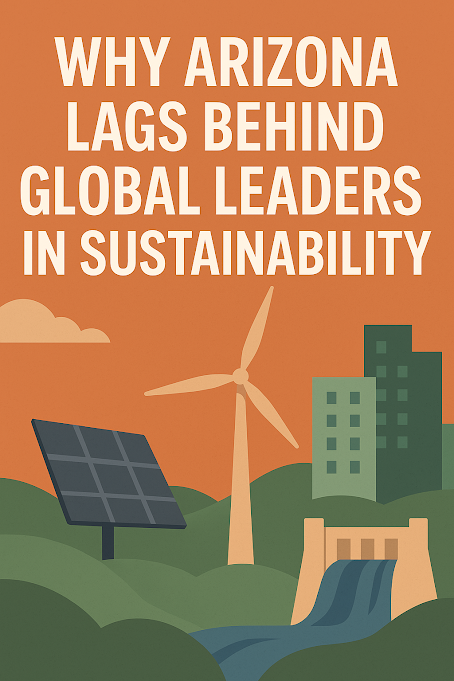Why Arizona Lags Behind Global Leaders in Sustainability
Arizona should be a sustainability powerhouse. With unmatched solar exposure, unique ecosystems, and a population increasingly aware of environmental challenges, the state has potential to lead. Instead, Arizona lags behind—especially when compared with countries like Denmark, Germany, Japan, and even developing nations like Rwanda or Uruguay. Why?
 |
| Digital graphic for blog post titled "Why Arizona Lags Behind Global Leaders in Sustainability," featuring icons of solar panels, wind turbines, water systems, and a cityscape. |
The reasons are complex: political gridlock, infrastructure gaps, weak regulatory frameworks, water mismanagement, and missed economic opportunities. But understanding these challenges is the first step toward building a greener, more resilient Arizona.
1. Solar Energy Potential vs. Reality
Arizona receives more than 300 days of sunshine a year, ranking it among the sunniest places on Earth. But surprisingly, it’s not even in the top five U.S. states for residential solar installations per capita.
The Problem:
Utility companies like Arizona Public Service (APS) have historically fought against rooftop solar expansion. From imposing demand charges to lobbying against net metering, these monopolies have slowed adoption.
Global Comparison:
-
Germany—with half the sunshine—has 2 million solar systems installed thanks to national incentives, feed-in tariffs, and accessible financing.
-
India aims to install 280 GW of solar by 2030 and offers free solar setups for low-income families.
Solution:
Arizona must streamline permitting, offer meaningful tax credits, and prevent monopolies from stifling competition.
2. Water Crisis in the Desert
Arizona’s water issues are no secret. With the Colorado River shrinking and Lake Mead at record lows, the state is rapidly approaching crisis levels. Agriculture, which consumes over 70% of the state’s water, remains largely exempt from modern water-saving techniques.
The Problem:
-
Outdated irrigation systems and water rights from the early 1900s.
-
Endless suburban development that doesn’t reflect desert-compatible living.
Global Comparison:
-
Israel recycles 90% of its wastewater and leads the world in drip irrigation.
-
Singapore uses a closed-loop water recycling system and advanced desalinization to meet national needs.
Solution:
Arizona needs to implement aggressive water conservation laws, incentivize desert landscaping, and shift agriculture toward drought-resistant crops.
3. Lack of Comprehensive Sustainability Policy
Arizona lacks a statewide climate action plan. Instead, individual cities—like Tucson and Phoenix—set fragmented sustainability goals, which are rarely enforced or funded.
The Problem:
Without strong, enforceable state-wide targets, climate and sustainability progress is disjointed.
Global Comparison:
-
Sweden has legally binding net-zero laws.
-
Costa Rica gets 99% of its energy from renewables and has national mandates for forest conservation.
Solution:
Arizona must adopt a unified, enforceable climate roadmap tied to economic development, public health, and infrastructure resilience.
4. Urban Sprawl and Transportation Failures
The Phoenix metro area is among the fastest-growing in the country—but growth has come at the cost of walkability, green space, and efficient transportation.
The Problem:
-
Low-density development increases car dependency and emissions.
-
Public transit is limited, unreliable, and rarely connects underserved communities.
Global Comparison:
-
Netherlands: Bicycles outnumber cars.
-
Japan: Trains connect every corner, reducing emissions and promoting efficient land use.
Solution:
Arizona must invest in smart growth policies, electrify transit, expand light rail, and rezone to favor mixed-use, walkable neighborhoods.
5. Waste Management and Recycling Deficiencies
Arizona has one of the lowest recycling rates in the U.S. Many cities have cut recycling programs altogether due to rising costs and contamination issues.
The Problem:
-
Poor education on recycling.
-
Lack of composting infrastructure.
-
Landfills prioritized over circular economy initiatives.
Global Comparison:
-
South Korea diverts 95% of food waste via smart bins and waste-to-energy facilities.
-
Switzerland boasts a 90% recycling rate through national sorting, incentives, and public participation.
Solution:
Arizona needs to establish statewide composting, standardize recycling education, and incentivize zero-waste businesses.
6. Environmental Justice and Indigenous Land Protection
Many sustainability gaps in Arizona disproportionately affect Native American communities, who often lack clean water, reliable electricity, and environmental protection.
The Problem:
-
Underinvestment in tribal infrastructure.
-
Historical environmental exploitation without remediation.
Global Comparison:
-
New Zealand recognizes Māori land and environmental rights in law.
-
Canada is investing billions in Indigenous clean energy and land restoration.
Solution:
Arizona must partner with tribal nations in planning, respect Indigenous land rights, and fund clean infrastructure projects.
7. Missed Economic Opportunities in Green Innovation
Arizona’s economy could boom with investment in sustainability. Solar manufacturing, green construction, water tech, and eco-tourism are all growth industries.
The Problem:
-
No cohesive green jobs plan.
-
Minimal investment in local green tech startups.
Global Comparison:
-
Denmark exports wind turbines worldwide.
-
Finland built a circular economy hub generating billions in revenue.
Solution:
Create tax credits, green business zones, and university-private sector partnerships to drive innovation and job creation.
Conclusion: It’s Not Too Late—But the Time Is Now
Arizona is uniquely positioned to become a leader in sustainability—but only if it commits to systemic change. We need bold policy, community investment, education, and long-term vision. By learning from countries already leading the way, Arizona can build a future that respects its environment, supports its people, and thrives economically.
Let’s make Arizona not just a place of natural beauty—but a model for sustainable living in the American Southwest.









Comments
Post a Comment